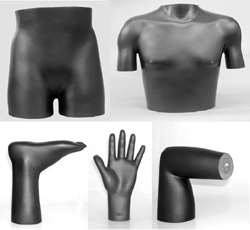Sectional Phantoms
Sectional phantoms are used when you require a human subject to train radiographers in the use of radiography equipment. The complete sectional phantom set and the individual sectional phantoms may be used repeatedly to learn how various positions and techniques will produce a variety of radiographic images.
A natural human skeleton is first reconstructed into the sectional molds of an average-sized male patient. With the bones set in place, the mold is filled with a specially formulated urethane material, the same as is utilized in the RANDO® phantom, which simulates the density of tissue and organs. This opaque material duplicates the X-ray absorbency, atomic number, and specific gravity of soft human tissue. Because the RANDO® material is virtually indestructible, these sectional phantoms will withstand substantial impact and continuous handling without damage.
Only natural skeletons are used in these anthropomorphic phantoms. Many skeletons reflect natural human characteristics such as lack of symmetry and distorted joints. As the technicians reconstruct the skeleton, minor adjustments may be made to facilitate positioning within the mold. The natural characteristics and the adjustments should not present any problems in the use of the phantom.
Model SK150, Head
The skull and cervical vertebrae are cast into the head phantom with an internal air cavity to represent the oral, pharynx and trachea anatomy. It is also available without the cervical vertebrae.
Model SK200, Thorax
The thorax phantom contains the chest and shoulder skeletal structures including the upper third of the humerus. The lungs' lower density is duplicated with a special material, the same material as used in the RANDO® phantom lungs, which has an atomic number and specific gravity of human lungs at a median respiratory state. This material is formed to the contours of the rib cage.
Model SK250, Lower Torso
The lumbar vertebrae, pelvis and upper third of the femur are cast into the lower torso phantom. A hollow cavity reproduces the interior of the sigmoid flexure with the diverticulum and rectum. This cavity is connected to the surface by a duct that is sealed with an O-ring screw cap. The cavity may be filled with contrast media. It is not discernible when filled with water.
Models XA235-L & XA235-R,
Left and Right Elbows
The elbow phantoms contain the lower third of the humerus and the upper third of the radius and ulna. The right elbow has a 90° flexion and the left elbow is extended.
Models XA231-L & XA231-R,
Left and Right Hands
The hand phantoms contain the lower third of the radius and ulna along with the carpal and finger bones. The left hand is pronated and the right hand is relaxed.
Models XA245-L & XA245-R,
Left and Right Knees
The knee phantoms contain the lower third of the femur, the upper third of the fibula and tibia, and the patella. The right knee has a 90° flexion and the left knee is extended.
Models XA241-L & XA241-R,
Left and Right Feet
The foot phantoms contain the lower third of the fibula and tibia along with the tarsal and toe bones. The left foot is relaxed and the right foot is in plantar position.
Model SP500, Complete Sectional Phantom
The complete set consists of 11 sectional phantoms including head, thorax, lower torso and the left and right elbows, hands, knees and feet. All come packed in a convenient wooden storage case.
RANDO® is a registered trademark of the Phantom Library
